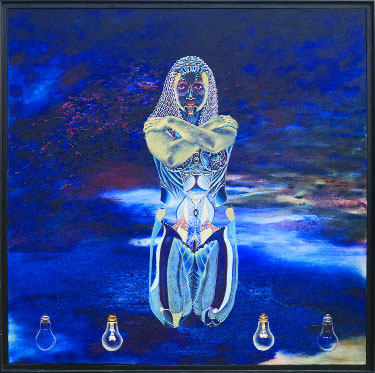For more than 30 years, artist Vasundhara Tewari Broota has explored the human figure and in the discourse, unravelled her own perceptions of a woman. By Uma Nair
When she was an English Honours student at Lady Shri Ram College in Delhi, she would represent it at university festivals. The art collage contests had students from all over the country. But three years in a row, she won all the awards and left the remnants for the others. Vasundhara Tewari Broota has for more than 30 years explored the human figure and in the discourse, unravelled her own perceptions of a woman and the psycho-political existence of the female body in society. Perfection and personification both play off each other on her canvasses and paper works. But more than anything else, it is her precision, accuracy and melodic moods that signify her brilliance and essence of an epoch that travels through the tryst of time.
Character and charisma
At the Sangeet Shyamala Celebration in Delhi, of which she is the director, her paintings speak about the feminine spirit as much as the avatar of Devi. Contemporary character and charisma both weave into her frames. In the public space of artistic domains, she first drew attention for her sensitive mixed media work in which an interpretation of the suppressed womanhood within the existing societal structure was contextualised by her female nude images. Her treatment and use of the female nude is both evocative and stirring, elegant and born of questions — she creates abstraction in thoughts and weaves an emblematic eloquence of the inner lives of contemporary women. Her women seep and float amid tensions arising out of their naturalistically modelled figures — above that it is the background, the flat pictorial space which she enriches with tiny islands of tonal recessions creating islands of nature with flora and plantar intricate details and elements.
Born of nature
Her Devis are individuals who live within the earthy tints of colour codes that she chooses. The blue tinted backdrop is a brilliant hue of expanse that runs into layers and textural terrain. “The blue one is a work that symbolises the spiritual as also the expanse of nature-the sea-the sky all those domains from earth bound realities,” she says. “The figure is both of the material as well as the spiritual and so the partial transparency in the body. The design on her is both the structure within as well as the armour to protect and guard. The red in the blue hints at violence. She is both ancient and modern and she hugs herself keeping herself protected. She is fierce but vulnerable. The bulbs reflect the light and glow within her. Some lit, some not. Where there is hope there is also uncertainty,” adds she.
Jagdishwari and Devi Durga
In another painting, she creates a Devi whose universe is under her feet as she seems to symbolise the word ‘Jagadishvari’ or ‘Ishvari’ of universe resounding in Ashiqur Kumar’s rendition of Jai Jagdishwari Mata Saraswati. The colour tones and fluid renditions reflect her rich repertoire of strokes and colourative chasms.
She explains, “The red canvas for Subrata was an image of Devi Durga, who’s the epitome of strength, courage and compassion. She emits the aura, the radiance when her devotees are in danger. Like a fierce mother, she takes care of them. She stands for power, compassion and peace that the dancer has depicted through her vocabulary of Odissi.”
In all these four paintings, we sense a sensibility towards the understanding of the internal and external psychological spaces, where ‘woman’ is displayed in lucid limp linearity. She plays between creating her figure as a protagonist as well as someone who shares an equi-focal space with the background. Experiences and ruminative reflections become a meaningful reality for Vasundhara. Devi and the celebration of the contemporary woman, participant and goddess unafraid to reveal her soul stands at the centre of her epoch.
























